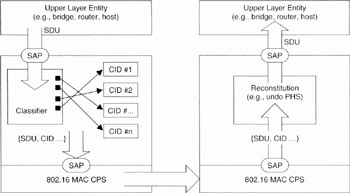7.3 Classification and Mapping
7.3 Classification and Mapping
As defined in the standard, classification is the process by which a MAC SDU is mapped on to a particular connection for transmission between MAC peers. The mapping process associates a MAC SDU with a connection, which also creates an association with the service flow characteristics of that connection. This process allows 802.16 BWA to deliver MAC SDUs with the appropriate QoS constraints.
Classification and mapping mechanisms exist in the uplink and downlink. In the case of a downlink transmission, the classifier will be present in the BS and in the case of an uplink transmission it is present in the SS.
A classifier is a set of matching criteria applied to each packet entering the WiMAX/802.16 network [1]. The set of matching criteria consists of some protocol-specific packet matching criteria (a destination IP address, for example), a classifier priority and a reference to a CID. If a packet matches the specified packet matching criteria, it is then delivered to the SAP for delivery on the connection defined by the CID. The service flow characteristics of the connection provide the QoS for that packet. The classification mechanism is shown in Figure 7.6.

Figure 7.6: Classification and CID mapping. The principle is the same for both ways: BS to SS and SS to BS. (From IEEE Std 802. 16-2004 [1]. Copyright IEEE 2004, IEEE. All rights reserved.)
The MAC of 802. 16-2004 is connection-oriented, where the connections are virtual. For the purposes of mapping simultaneous different services and associating varying levels of QoS, all data communications are in the context of a connection. Service flows may be provisioned when an SS is installed in the system. Shortly after SS registration, connections are associated with these service flows (it should be remembered that there is one connection per service flow) to provide a reference for the process of bandwidth request. Additionally, new connections may be established when an SS service needs change. A connection defines both the mapping between peer convergence processes that utilise the MAC and a service flow. The service flow defines the QoS parameters for the PDUs that are exchanged on the connection.
In short, the MAC CS Layer classifies each application. A QoS class is assigned. This classification is an important process because each BS may serve a relatively large number of users transmitting different applications. This classification allows a good link adaptation, because it will allocate the needed resources for each application. Consequently, the QoS differentiation, e.g. between an email and a voice transmission, is very easy to implement.
A Dynamic Service Addition (DSA) MAC management message allows the creation of a new service flow. MAC management messages are introduced in Chapter 8. The use of a DSA message for the creation of a new service flow is detailed in Chapter 11. The attributes of QoS are now given.
EAN: 2147483647
Pages: 124